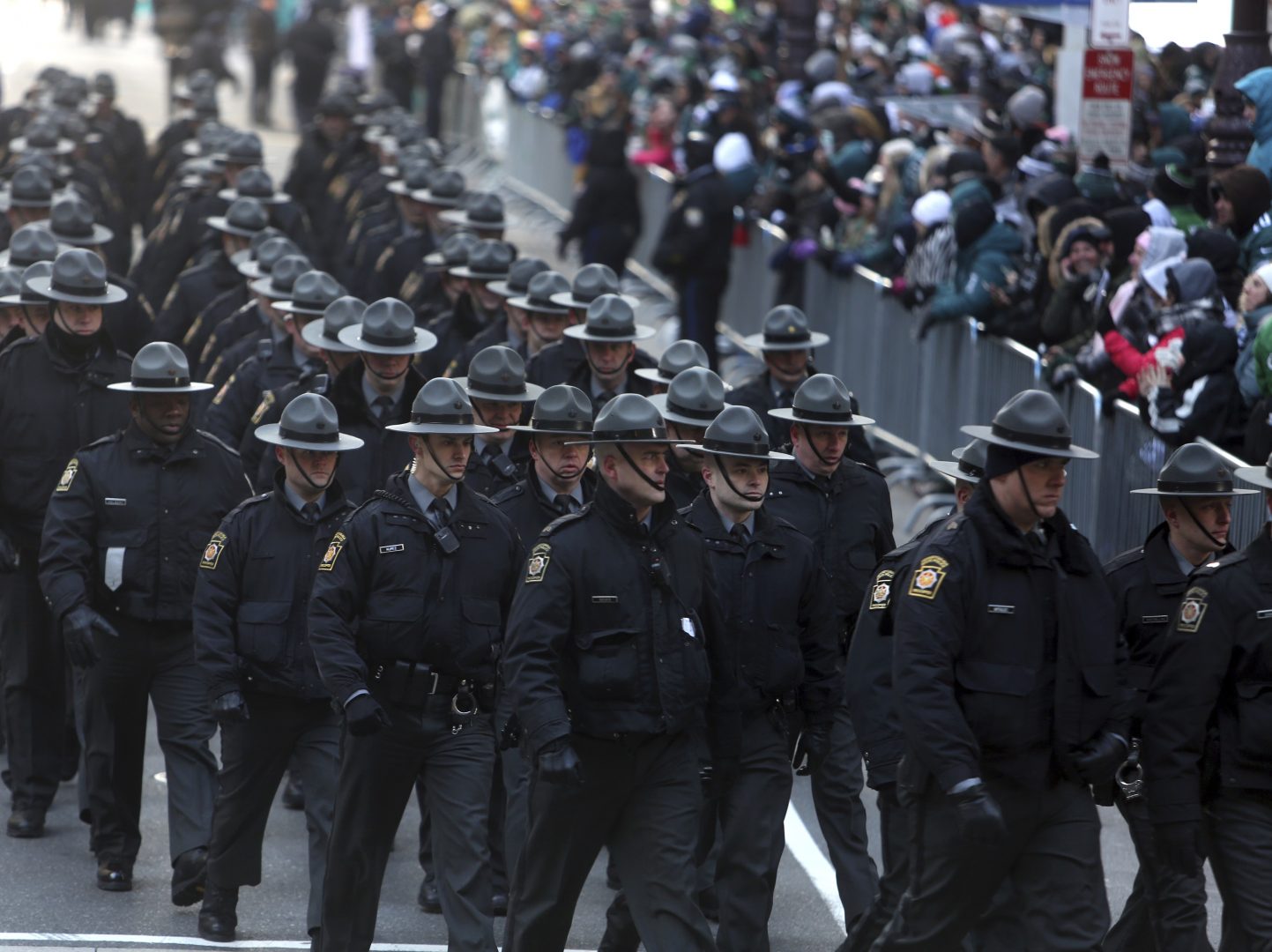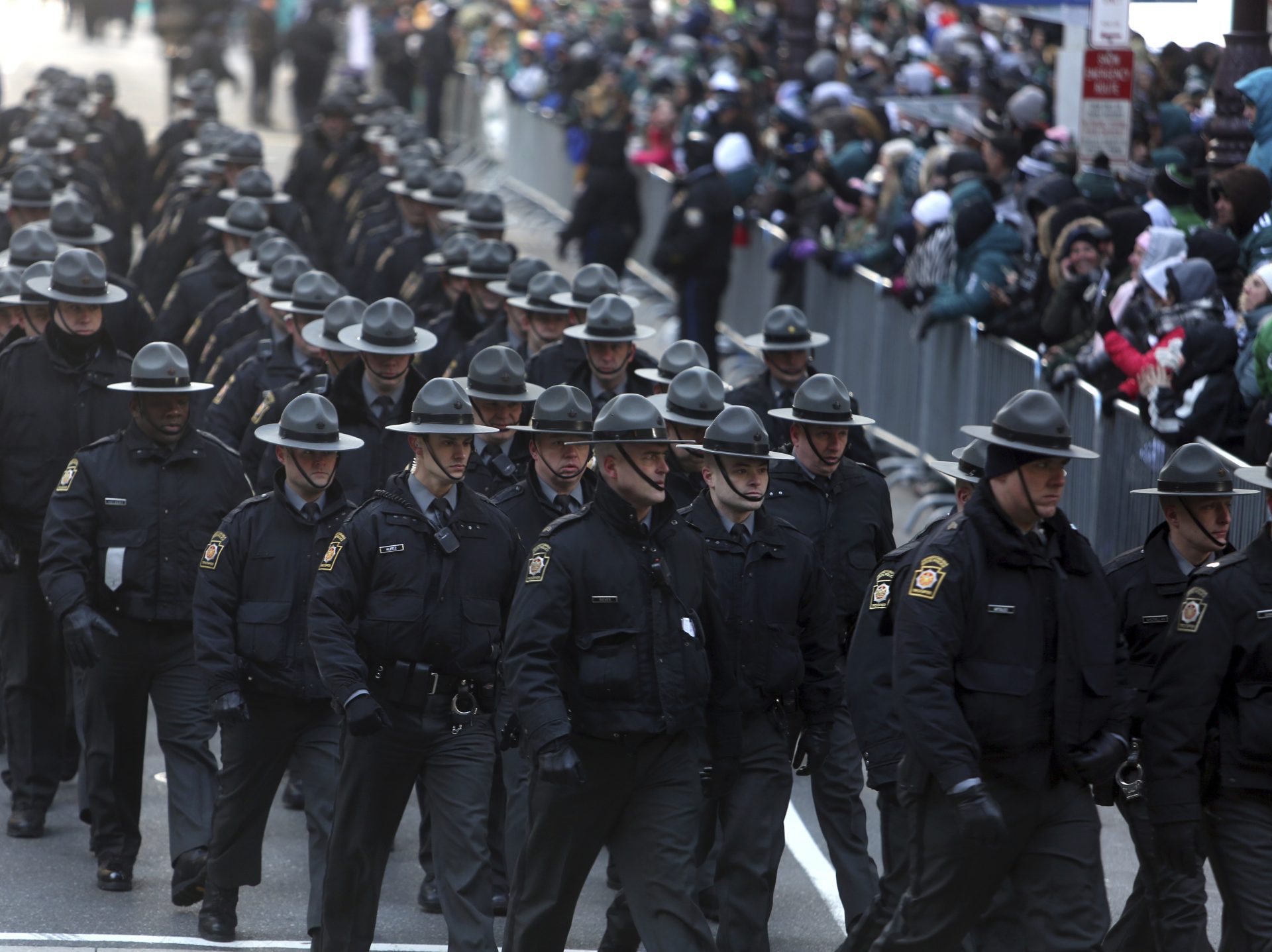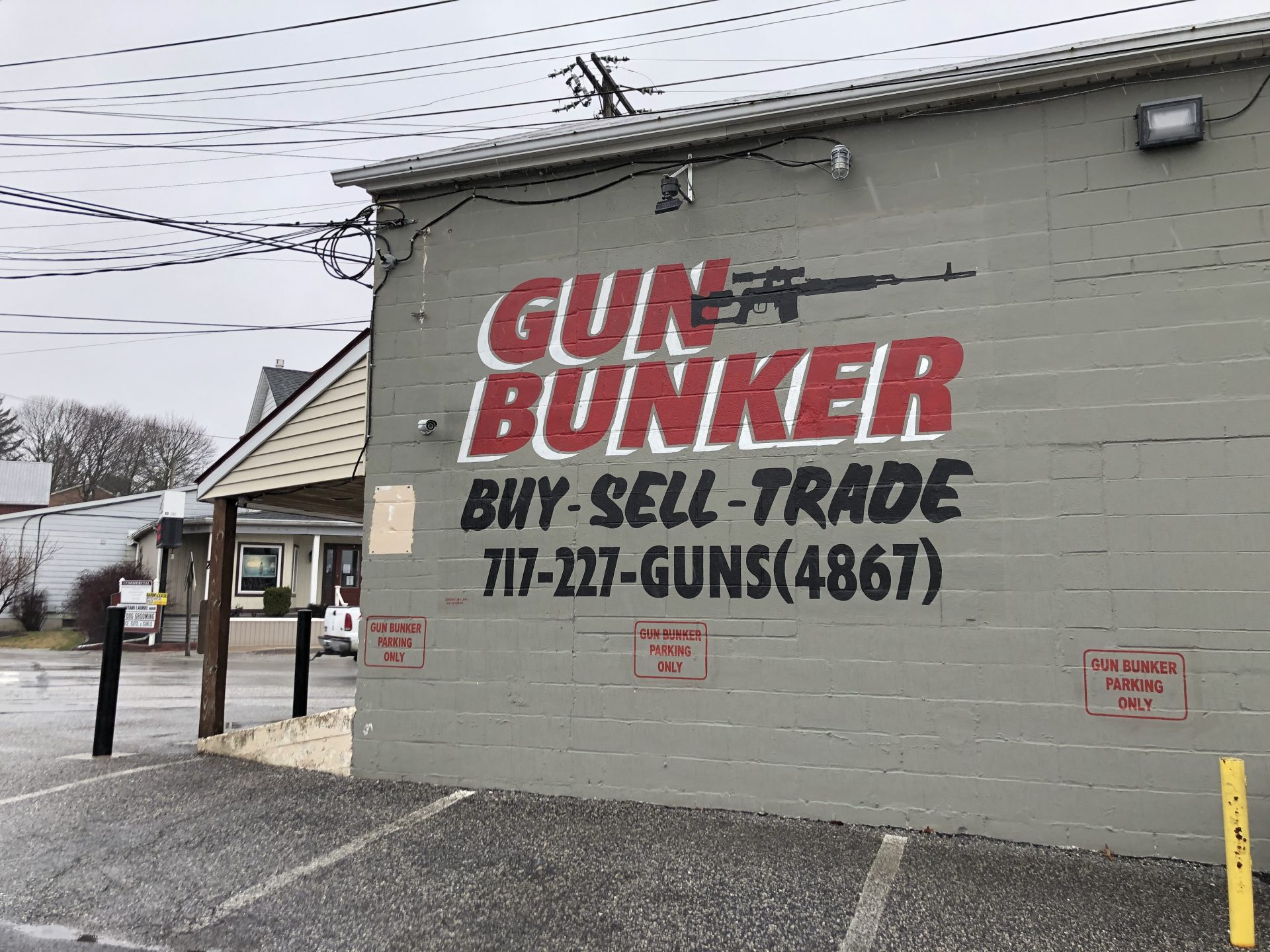
FILE PHOTO: State Police deploy before the Eagles team parade and celebration Thursday Feb. 8, 2018 in center city Philadelphia.
Jacqueline Larma / The Associated Press

FILE PHOTO: State Police deploy before the Eagles team parade and celebration Thursday Feb. 8, 2018 in center city Philadelphia.
Jacqueline Larma / The Associated Press

Jacqueline Larma / The Associated Press
FILE PHOTO: State Police deploy before the Eagles team parade and celebration Thursday Feb. 8, 2018 in center city Philadelphia.

Jacqueline Larma / The Associated Press
FILE PHOTO: State Police deploy before the Eagles team parade and celebration Thursday Feb. 8, 2018 in center city Philadelphia.
Almost a quarter of Pennsylvania’s municipalities rely on Pennsylvania State Police for law enforcement services. Hundreds of communities rely on PSP coverage part-time, while close to 1,300 townships and boroughs utilize troopers as their local law enforcement instead of financing their own departments.
The result is that state troopers are being forced to step into the role of community police officers, responding to everything from serious felonies to small infractions.
PA Post and our partner news sites have covered this issue in the past, primarily from a financing perspective. Funding for the PSP is a consistent topic for debate during the annual budget season in Harrisburg; the department’s funding has been offset for years by the Motor Vehicle Fund, which is meant for repairing interstate roads and bridges.
But amid the protests across the nation and continuing conversations about the role of police and the ability to hold law enforcement officers accountable, police reformers, legislators and even the state police themselves say troopers aren’t suited to be substitutes for community officers. Instead, they say, it’s time for local communities to start funding their own police forces and investing in services that address many of the issues that often fall to police.
It’s an interesting twist to the “defund police” argument. One area of agreement between police reform advocates and leaders of police unions is the view that police departments are being asked to do too much.
It’s not that Pennsylvania State Police can’t provide coverage for local communities or lack the tools to do so. In fact, troopers are better trained in de-escalation techniques compared to many municipal departments. And by law, troopers must meet a higher standard of training with more hours in cadet school.
But more training doesn’t make a community police officer. Some cities — including New York, Philadelphia and Camden (NJ) — have established protocols that call for officers to be part of the neighborhoods and towns they’re policing. That way, officers have a stake in maintaining order in their communities and, more importantly, a connection to more of the people they are charged to protect.
Police officers committed to the community policing model aren’t trained social workers. Yet, they’re first to respond when there is, for example, a mental health check or domestic violence call. In a Senate hearing on policing and the criminal justice system last week, Brandi Fisher, president and CEO of the Alliance for Police Accountability, said police are called to respond to civil issues that would be better suited for social workers.
“Too many social problems were laid at the doorsteps of the police,” she said, adding that the money for police departments should be allocated to more community services.
It’s a central complaint from protesters in the nation’s largest cities over the past month. But those protests have also made their way into rural areas – areas where State Police typically have jurisdiction.
PSP officials say that defunding the police — i.e. shifting funds from police departments to social services — is not a simple calculation. That’s because 80 percent of police budgets is spent on personnel, said Scott Price, deputy commissioner of operations for PSP.
He said that if all is on the chopping block, equipment (such as guns, tasers or protective vests) won’t be the first to be cut, it’ll be the troopers. Meaning even fewer officers able to respond to calls from towns or boroughs that lack their own police departments.
You can read more on my story about the complications around funding (or defunding) our State Police here. —Joseph Darius Jaafari
Related News:
A very, very long letter: Pittsburgh Mayor Bill Peduto responded to Black Lives Matter and other activists this week in a 5,000-word essay addressing each of their 12 requests, such as demilitarization of the police, defunding the force and investing more in social services. You can read his letter here, and the list of requests here.
PennLive: June 30 Facebook Live Town Hall on Police, Race and Equality to respond to reader demand
The Atlantic: Who Gets to be Afraid in America?
Vox: Why Senate Democrats just tanked the Republican police reform bill
The Philadelphia Inquirer: Self-styled ‘vigilante’ arrested in assault at South Philly’s Marconi Plaza
PennLive: Luzerne County OKs $3M settlement over inmate’s death

Ed Mahon / PA Post
Gun Bunker in Shrewsbury, York County, was closed on March 23, 2020, the first day of enforcement for Gov. Tom Wolf’s order to close “non-life sustaining” businesses. The next day, Wolf said gun shops could open but with restrictions.
Emergency firepower: The Pa. House passed a Republican-backed bill that would eliminate the governor’s authority to restrict firearm purchases during an emergency declaration, as he’d done at the beginning of the coronavirus pandemic. The bill passed through the house bipartisanly, with opposition from groups like CeaseFirePA and Moms Demand Action for Gun Sense in America. Ed Mahon has that story for us here.
Biden in central Pa.: Democratic presidential candidate Joe Biden will be in Lancaster today to talk about Obamacare. Few details were released by his campaign on where Biden will speak, but LNP has sussed out some info. The last two Democratic Party nominees to visit the city were Barack Obama and John F. Kennedy.
Gender commission proposals: WESA reports that Pittsburgh’s Gender Equity Commission offered 11 policy proposals to address disparities among women of color in the city. The commission was established a year ago and tasked with finding out what were the root causes of poorer health and financial outcomes for communities of color. Top on it’s list of reforms? Police. But while policing isn’t an immediate and direct cause of all the issues, the political and civil climate made for an opportune moment to address women’s safety.
Reading birth center: PA Post’s Anthony Orozco looks at how citizens in Reading and Berks County are organizing to save a maternity and prenatal care center there. The grassroots effort has succeeded in getting the attention of at least one local legislator.
Schoooool’s back (maybe): The state’s 14-institution public university system – Bloomsburg, California, Cheyney, Clarion, East Stroudsburg, Edinboro, Indiana, Kutztown, Lock Haven, Mansfield, Millersville, Shippensburg, Slippery Rock, and West Chester — educates more than 100,000 students statewide. Those schools face increasing uncertainty in regards to finances and enrollment due to the coronavirus. Yesterday, the Pa. Senate passed a proposal that would consolidate the system’s governing board and give it the authority to make tough decisions — like closing or consolidating campuses. The bill still has to clear the House.
166 years: Middletown’s newspaper, the Press& Journal, is closing up its shop on July 1. The coronavirus’s impact on the economy was the final straw for a community paper that was already facing tough competition. PennLive has an exclusive interview with paper’s publishers on their decision to stop the presses.
Required quarantine: Three states, including two bordering Pennsylvania. – NJ, NY and CT – are requiring people to self quarantine for two weeks when travelling in from coronavirus hotspots like Florida. As of yesterday, half of the nation has seen an increase in cases. Pennsylvania is not one of them, though the Philadelphia Inquirer reports about worries that new cases will plateau, but not decline, as counties go green.
83,191 cases: That’s the total of COVID-19 cases in the state as of yesterday. The state has also recorded 6,515 deaths.
Other reads:
Lehigh Valley Live: National Guard headed back to Gracedale to help with testing
GoErie.com: Erie County sewage shows huge spike in COVID-19
The Morning Call: No fans at Pocono Raceway means more economic struggles for businesses amid coronavirus
New York Times: Decades-Old Soviet Studies Hint at Coronavirus Strategy
WESA: Wolf Administration Wants More Flexibility In Adminstering Food Assistance During Pandemic
The Philadelphia Inquirer: Philadelphia announces plans to remove Columbus statue after repeated violence at Marconi Plaza
PublicSource: Columbus, Foster, Parran: Pittsburgh’s reckoning with historic symbols intertwined with racism
Vogue: Ritchie Torres and Mondaire Jones Are Poised to Make LGBTQ+ History in Congress
The days of journalism’s one-way street of simply producing stories for the public have long been over. Now, it’s time to find better ways to interact with you and ensure we meet your high standards of what a credible media organization should be.